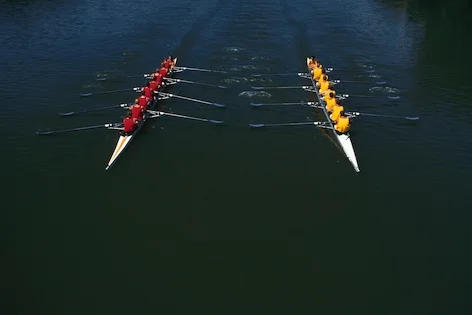All boats used in rowing are called shells.
Some shells are called sculls.
In a scull, each crew member rows with two oars called sculling oars.
Sculls can be made for a single rower, two rowers or four rowers.
All rowing boats are shells, but some are called sculls and these are rowed by one rower, two rowers or four rowers.
The extra crew member in an eight person crew is the coxswain © Getty images
A shell that is not a scull has can have two, four or eight rowers who each have only one oar.
It is called a sweep oar and the rower holds onto it with both hands. In this type of shell there can be two, four or eight rowers.
The coxswain steers a boat with eight rowers
The eight-person crews have a coxswain (say cox'n) who steers the boat and directs the crew, but in all other boats one rower steers by controlling a small rudder with a foot pedal.
Shells are from 8 metres long for a single scull to about 20 metres for a crew of eight. They are made of high technology materials such as kevlar and graphite fibre. Some are made of ultra-thin plywood.
A quadruple scull has four rowers without a coxswain. ©Getty Images
Rowing at the Olympics
There are rowing events for single rowers, doubles and fours, as well as crews of eight. The competition is for both men and women.
Rowing became an Olympic sport for men in 1900 and for women in 1976. Races are held over a 2000 metre course.
Watch some Olympic rowing events
Read about Rowing at the Olympics in Paris 2024
History of rowing
Getty images
The ancient Chinese may have been the first people to race in longboats.
In Egypt, as long ago as 2500 B.C. oared barges were raced on the Nile River.
The ancient Greeks and Romans travelled in huge rowing boats called 'galleys'.




